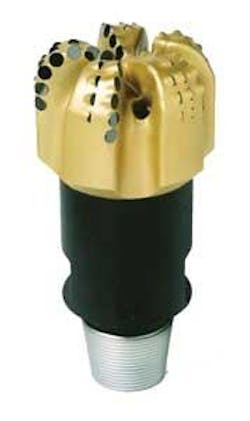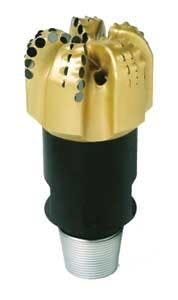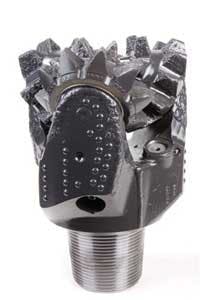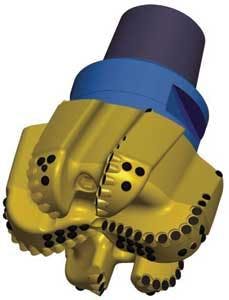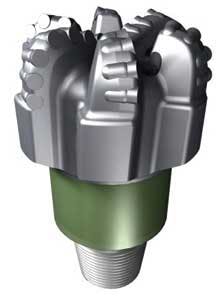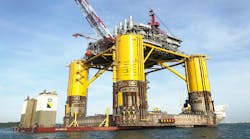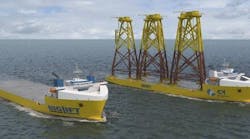Frank Hartley, Editor, Drilling & Production
As more wells are drilled deeper and into harder and more-abrasive formations, challenges for drill bits in terms of rate of penetration (ROP) and durability are more demanding. The worldwide increase in drilling activity has led to increased rig rates. Drilling engineers have to re-evaluate bottomhole assembly designs, drilling processes, drilling fluids, and applications to reduce costs.
Drill bits have a significant impact on opex. They have to drill faster and last longer. This is what drilling engineers have come to expect from the bit companies.
Different types of drill bits are available for various applications. These types include polycrystalline-diamond-compact (PDC), impregnated, and roller-cone bits.
Bit-behavior analysis with different vibration modes has become standard. These analyses have led to new PDC cutters with high abrasion resistance. The cutters stay sharper longer to improve ROP and durability.
Substantial ROP and durability improvements also are seen with impregnated bits. These improvements resulted from detailed evaluations on the effects of drive tools (rotation speed and power regime), downhole-pressure environment, and depth of cut on impregnated bit performance.
New technologies are improving seal reliability and cutting-structure durability for roller-cone bits. Also, new developments in metal-seal-bearing technology have increased the on-bottom drilling time of roller-cone bits.
The following drill bit companies have developed new designs.
Hughes Christensen
Hughes Christensen says the Quantec PDC drill bit for tough applications incorporates a new design process, highly impact- and abrasion-resistant cutters, and formation-specific bit design. Each Quantec PDC is matched to a specific task for higher average ROP, greater durability, greater stability, and lower drilling cost, the company says.
According to Hughes Christensen engineers, they have developed a group of cutters to push performance in these applications. For extremely abrasive applications, this technology increases cutter life and cutting-edge integrity while maintaining durability. In applications where impact and vibration, and inter-bedded formations shorten cutter life, the cutters maintain an edge longer, say developers.
An engineering and research initiative developed a new PDC bit design philosophy named diamond volume management (DVM). Based on DVM, the company increased mechanical and hydraulic efficiency of each bit for higher ROP and longer runs. The company says this light-set technology increases drilling effectiveness without compromising bit or BHA stability. Close attention is given to the interval to be drilled so neither ROP nor durability is compromised by bit design. In hundreds of runs, the ROP has improved more than 50% compared with the offsets in hard and abrasive formations, says the company.
Hughes Christensen says that the design improvements with this bit include the patented SmoothCut depth-of-cut control technology, balancing the workload over more cutters, and the Lateral Movement Mitigator to reduce bit vibration and increase resistance to whirl.
The company says one operator drilled a well with inter-bedded sandstones and shales, high mud weights, and overburden pressures leading to high confining pressures in an anticline slimhole interval using five-bladed PDC bits. Another operator chose the 6-in. Quantec Q405 and Q505 and drilled the slimhole interval 72 hours faster than the average offsets. This was a 35% reduction in drilling time for a $114,000 savings on a single well. In a situation where the operator drills one well per month, this was nearly a $1.4 million savings over the course of a year per rig, the company says.
Halliburton
In any drilling application that encounters soft, unconsolidated formations, challenges associated with inability to clean and cool the bit prevail. When bit hydraulics are taxed by removing heavy gumbo cuttings, flow efficiency can be compromised, leading to cuttings re-circulation and pack off, which further limits flow efficiency and drilling performance.
Halliburton says that in an effort to mitigate these problems by improving flow efficiency, roller cone bit manufacturers have attempted to design bits that better control fluid flow through use of varying nozzle designs and configurations. A typical solution has been to create “directed hydraulics” by orienting bit nozzles in a specific direction to direct the flow, the company says.
The company says that in conventional roller cone designs, this approach to “directed hydraulics” typically results in flow regimes that generate a turbulent flow in the vicinity of the cutting structures. Rather than lifting cuttings, the turbulence may inhibit or even prevent cuttings removal from the bottom of the hole. As a result, cuttings are re-circulated, hole quality suffers, penetration rate drops, and bit life is cut short, the company explains.
Based on the latest advancements in fluid flow optimization, Halliburton says it has developed a new bit design platform that incorporates engineered hydraulics to overcome the flow problems inherent in conventional roller cone designs by capitalizing on the way a roller cone bit works.
Working with a major university lab and using Computational Fluid Dynamics (CFD) software to determine the optimal fluid-flow regime for cuttings removal, Halliburton’s Security DBS Drill Bits were tested to examine fluid interaction with the bit and flow impact on the hole and its entire environment.
The company says the CFD indicated and the testing verified that optimized arm geometry would mitigate problems with turbulent flow by creating directed flow channels to provide more efficient cuttings removal, contributing to higher ROP and longer bit life.
However, unlike conventional “directed hydraulics,” which positions bit nozzles in a given direction, the concept of engineered hydraulics focuses on optimizing fluid flow efficiency to clean and cool the bit by improving fundamental aspects of bit design, beginning with the profile design.
The resulting hydraulics design, according to the company, orients bit nozzles toward the leading edge of the cutting structure, to effectively move stagnant zones off the cutting structure, to improve cleaning, and to reduce the quantity of re-drilled cuttings for faster penetration rates.
Comprising an improved bit design platform, these insights have been incorporated into a proprietary engineered hydraulics system introduced in the QuadPack Plus line of roller cone bits. To fully exploit the benefits of engineered hydraulics, Halliburton says, the platform also incorporates four specific longevity design features to increase roller cone reliability. These include larger bearing load capacities; greatly improved seal dependability; a more responsive pressure compensation system; and new, stronger body forgings, all of which combine to extend bit life, the company says.
In late 2006, Halliburton field testing of QuadPack Plus bits resulted in dramatic improvements in ROP, cost per foot and reliability, and led to widespread use in high-cost applications that demand long life and durability. In the Gulf of Mexico alone, more than 150 successful runs have been documented.
The company explained that in one West Cameron well, a 9 7⁄8-in. QHC1R bit with engineered hydraulics was run on a motor to drill a single run of 5,546 ft (1,690 m), outperforming all offsets in terms of footage drilled. Exhibiting minimal erosion on the spear point, the bit was pulled with all seals effective after 102.5 hours, the highest achieved to date.
ReedHycalog
ReedHycalog recently introduced RockForce bits in slimhole and in mid-range diameters of 7 7⁄8-in. through 12 ¼-in., along with the redesigned RockForce bearing used in both the TuffCutter and RockForce series.
Featuring technologies in design, materials, and manufacturing, ReedHycalog says the bits have a new bearing design along with other features including:
- Seal type optimized for the bearing size increases life and consistency
- Specially formulated, proprietary synthetic grease which maintains its properties longer
- Ventrite pressure compensation system for longer bearing life
- Encapsulated ball race design to reduce contact stress, and to improve load capacity and reliability
- Tighter tolerances and clearances for more consistent performance
- Precision machined, silver-plated surfaces to reduce friction and extend life.
The bearing is now incorporated in slimhole diameters in both tooth and inserts bits that also include additional technologies such as MudPick hydraulics, SuperTuff inserts, and MatchFit insert retention, says the company.
ReedHycalog says it introduced the secondary ‘hybrid’ components in the early 1980s, but with the recent major advances in design methodology, metallurgy, and cutter technology, the opportunity to fine-tune the use of hybrids was explored through testing.
The result, supported by extensive field trials, is SmoothTorque TCC (Torque Controlling Components) that uses PDC inserts specifically placed in the center of the drill bit, behind and between the primary cutting structure. The TCC limits sudden increases in torque by preventing the cutting structure from taking an excessive bite into the formation. The company continued to say the offset of the components is critical to torque control and can be modified readily, allowing the cutting structure to be optimized for penetration rate, rather than limiting the ROP to control torque. This is a major advantage over design that fixes the offset at the manufacturing stage, ReedHycalog says. Although ideal for directional motor assemblies, the SmoothTorque TCC also effectively reduces the risk of vibration, the company says.
Smith International
IDEAS, the Integrated Dynamic Engineering Analysis System bit designs are developed using a proprietary simulation process to model the total drilling system, all the way from where each individual cutter contacts the formation, through each component in the BHA, all the way up to the surface drive mechanism. Through a regimen of refining and upgrading laboratory-derived rock mechanics data and the simulation algorithms, Smith says it has brought accuracy to the evaluation of bit performance in a virtual environment, and is using this to design, build, and supply PDC and roller cone bits in a wide range of applications.
Smith says the IDEAS process certifies the performance capabilities of each bit design through dynamic simulation and modeling that takes into account not just the lithology at the rock/cutter interface, but also the drillstring, the drive system, the BHA, and the total system’s influence on the bit’s behavior. The new Smith bit designs for both roller cone and PDC bits, are developed using IDEAS, the company says. This process starts with bit performance data, geological information, BHA details, and dull bit analysis. Additionally, actual laboratory rock/cutter tests are carried out for the target formations. The company continued to say that the laboratory data from IDEAS quantify actual cutter forces and rock removal rates which then are used for the design analysis in lithologies that compare to the particular field application.
Smith says once the actual rock/cutter data is obtained, it is integrated into a full bit design model to determine the characteristics of the bit in actual drilling conditions. Not only does this allow examination of the bit in a confined mode for initial design development, but it also delivers an accurate projection of a bit’s performance considering the actual BHA under the actual well characteristics (geometry, parameters and lithology variations) in a dynamic simulation where the influences on the bit are virtually identical to those in the real drilling environment, the company says. Output from these simulations enables the designer to “match” the projected performance to the desired performance, be that ROP or footage drilled, and to help ensure that the highest degree of dynamic stability is engineered into the bit.
Smith says IDEAS has demonstrated that a single bit design can provide exceptional drilling performance with a range of different types of directional drilling systems, provided the bit has been designed to remain dynamically stable. The use of IDEAS to analyze conventional directional bit designs helped reveal that, in many instances, the range of special directional features previously incorporated into a bit served as little more than a crutch that allowed an unstable bit design to drill acceptably in a specific directional application, says the company.
Smith says because IDEAS technology can be used as an applications tool, it is possible to model precisely and to predict how several different IDEAS or non-IDEAS bit designs will perform in given formation types, with a specific rotary steerable system, with specific operating parameters, and with a specific BHA configuration. It’s like having the opportunity to drill the same interval multiple times with different bits and then being able to pick the best one, Smith says.
Tri-Max Industries
Tri- Max says the implementation of a concentric underreamer to simultaneously drill and underream has provided many benefits to the operator including better directional control and improved ROP. In the past, the use of enlarge while drilling (EWD) tools for underreaming operations in deep oil and gas wells has been challenging, especially drilling hard abrasive formations, due to the risk and cost, the company says.
The company explains that the EWD is a mechanical, or weight activated, concentric underreamer that proved through testing the advantages of a balanced cutting structure coupled with a solid steel support for the cutter blocks. The Ronnye Kettler Special (RKS) design incorporates a longer cutter block with nearly double the amount of PDC inserts while keeping the design advantages of more cutter block support developed in the Dave Tubbs Special (DTS) design plus a longer stabilization gauge to enhance cutting stability and further eliminate vibration issues, Tri- Max says.
The symmetrical design of the tool and cutters distributes even wear to all three cutters, extending the life of the cutters and generating smooth torque, the company says. Each cutter is inserted from the inside of the housing outward with a matching taper design. Tri- Max says, this geometrical configuration allows the cutters to retract easily and eliminates the risk of losing a cutter in the hole.
The company explains that below the cutters they had strategically placed interchangeable reverse jet nozzles with a patented tilt angle design that creates a strong vortex and sucks the cuttings up and away from the bit face, promotes good laminar flow with relatively low flow rates, and reduces cutting slip velocity. This action eliminates regrinding of cuttings, and prevents the bit from balling up, plus results in lower equivalent circulation density (ECD) thus creating the effect of drilling underbalanced, Tri- Max says.
There are no pressure limitations to the tools and the reverse jet nozzles will absorb approximately 20% of hydraulic flow while creating a vortex effect that keeps the bottomhole clean, the company says. This needs to be taken into account when calculating bit hydraulics but it is important to note hole cleaning is not completely dependent upon jet velocity and hydraulic horsepower/square inch, Tri- Max says.
The concentric reamer cuts less of the hole due to the full gauge bit drilling most of the formation while the ROP is controlled by the bit which is firmly stabilized on hole bottom, the company says.
Varel International
Varel International says the drill bit is designed to match the rotary steerable system (RSS), directional goals of the well, and formations to be drilled.
“Tailoring the drill bit to the rotary steerable system is a very effective drilling solution for operators,” says Bruno Cuillier, Eastern Hemisphere PDC product manager for Varel International. “By considering the RSS and the bit as a ‘drilling system,’ we can help enhance drilling efficiency.”
Engineers in Varel’s R&D group say they have used field run data and laboratory tests to develop tools that aid in designing the most effective bit for the drilling system. The design tools take into account the type of system employed, point-the-bit or push-the-bit, as well as the power generated and drilling characteristics delivered by each drilling system, the company says.
Varel’s Navigator bits, the company’s PDC bits used for directional drilling, are custom designed to the operator’s specific directional profile and formation requirements. To do this, Varel engineers say they consider the operator’s parameters for dogleg severity, borehole quality, and ROP through the formations to be encountered. The bit’s ability to achieve a given wellbore objective relies upon two key design factors: steerability and directional behavior, Varel says.
Alfazazi Dourfaye, R&D manager for Varel, explains why the company made this research of tailoring the drill bit to the rotary steerable system a priority. “Some RSS tools are more aggressive than others and we have to take this into account when designing the bit. The same bit designed for a Baker Hughes Inteq drilling system should not be used on a Schlumberger PowerDrive system. Each drilling system comes with it own unique characteristics and capabilities; therefore, the bit should be specifically designed to complement the individual system.”
Varel says the bit’s ability to achieve a given wellbore objective relies on two important design factors: steerability and directional behavior plus gage design influences both of these factors.
“The gage is what gives the bit its lateral aggressivity and steerability,” says Cuillier. “It is imperative to design the gage to complement the drilling system. To give an example: We don’t want to design an extremely gage aggressive bit for a drilling system that has a propensity to ‘walk.’ This pairing would make the bit too aggressive, making it too difficult to control the bit, which will result in low drilling performance and the operator missing the target. So, for optimum drilling efficiency it is important to pair the drill bit to the drilling system.”
For example, on a point-the-bit system, gage length affects and influences the bit’s performance when it is in “hold mode” and when it is in “directional mode,” the company says. Varel engineers design all Navigator directional PDC bits to drill effectively in both modes. The gage is designed so that it is has less torque and minimizes the potential for stick slip issues when in “directional mode,” Varel says. When the bit is in hold mode, the gage design complements the RSS tool resulting in better wellbore quality and higher ROP.
Alternatively, in push-the-bit systems, the gage is designed differently to optimize the characteristics of the RSS tools, the company says. In these circumstances, due to the nature of the RSS tools, Varel says the active gage design is used to improve drilling efficiency and wellbore quality. When building angle the active gage design engages the formation to ensure the bit meets the dogleg severity requirements, the company says.
Varel says to further enhance the directional capabilities of the Navigator bits, additional matrix material in the shape of an o-ring is placed directly behind specific cutters. This additional material helps manage the torque generated by modern RSS tools while maintaining orientation for increased ROP and reduced sliding time, the company says.
When drilling a directional well, negative occurrences like hole wall sloughing, keyseating, or severe dog legs can occur. Varel says its updrill feature, a standard feature on Navigator products, allows hole wall cleaning as you ream the wellbore helping eliminate such problems.
Varel says the development of specific tools to design bits for use in directional work has provided drilling optimization and success as presented in the following:
One example is the success in the Eastern Hemisphere with the 8 1/2-in. VRT619G. The bit was specifically designed to run on PowerDrive Vortex from Schlumberger. The bit entered the well at 5,215 ft and 0° incline and drilled 3,178 ft in 59 hours while building angle to 86° inclination. According to Varel, the results were a 21% ROP improvement over the best previous run completed in the same field. For this well, the bit went in with 27° inclination already built.
On another project, the same operator experienced an increase in ROP by 44% and achieved the best overall drilling performance for a particular field when the company’s 8 1/2-in. VRT619G was used. Again, the bit was designed for Schlumberger’s PowerDrive Vortex RSS tool. The bit entered the well at 5,524 ft with a 20° angle already built and drilled to finish the section at 9,145 ft and 86° inclination. This run beat the best offset, which stood since June 2006, by 20.5 hours drilling time, the company says.
